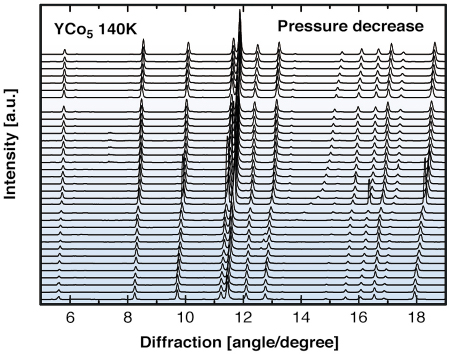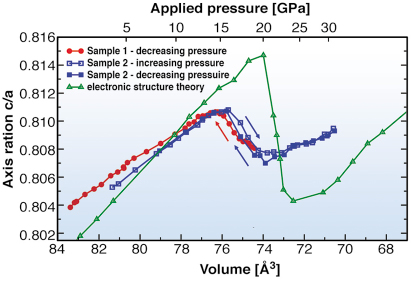- Home
- Users & Science
- Scientific Documentation
- ESRF Highlights
- ESRF Highlights 2006
- Materials Science
- Magneto-elastic lattice collapse in YCo5
Magneto-elastic lattice collapse in YCo5
Symmetry conserving collapses of crystalline lattices at elevated pressures are a particularly fascinating phenomena, well-known examples being samarium sulfide and cerium metal. Both transitions with about 15% volume reduction are ascribed to reorganisations of 4f-electrons. In contrast, the lattice collapse of YCo5 is driven by magnetic interactions of itinerant 3d electrons. In the present investigation, the associated magnetoelastic anomaly was studied by a combination of ab initio electronic structure calculations and high-pressure X-ray diffraction experiments.
Cobalt metal exhibits the most stable magnetic structure of all chemical elements and compounds. This is indicated by its very high magnetic ordering temperature Tc ~ 1400 K. When cobalt is diluted with moderate amounts of non-magnetic metals, its tendency for strong magnetic coupling is essentially preserved. Co-rich intermetallic compounds like Y2Co17 (90% Co, Tc ~ 1200 K) or YCo5 (83% Co, Tc ~ 1000 K) are strong ferromagnets with completely filled majority spin states in the Co-3d subband, i.e. the Co spin moment is only slightly reduced by hybridisation. Compounds of such compositions (SmCo5 and Sm2Co17) are frequently used in permanent magnet applications. YCo5 combines a high ordering temperature with a pronounced sensitivity to pressure.
We have studied the electronic structure of YCo5 by means of the full-potential local-orbital (FPLO) computational method [1] and found a transition to a low-spin state at a pressure within the experimentally available region. The computational results predict a reduction of the magnetic moment by one third which is coupled with a small, discontinuous contraction of the lattice. Although the transition is symmetry conserving with respect to both the lattice and the atomic positions, the abrupt change of the lattice parameters is calculated to be significantly anisotropic.
 |
|
Fig. 16: X-ray diffraction diagrams at 140 K in the direction of decreasing pressure. |
Angle-dispersive X-ray diffraction experiments at high pressures and low temperatures were performed at ESRF beamline ID09A to experimentally investigate the predicted anomaly. The measured X-ray diffraction patterns (Figure 16) exhibit the predicted anomalies of the lattice parameters but no indication of any symmetry change. Consequently, the transformation that YCo5 undergoes at 19 GPa is a symmetry-retaining phase transition. The experimental results (see Figure 17) are in perfect agreement with the theoretical volume dependence of the lattice parameter ratio, c/a. The comparison of theoretical and experimental data facilitates an assignment of the sudden change of c/a at 19 GPa to the predicted magneto-elastic transition. This is the first-ever observation of a pressure-induced isomorphic volume collapse of an itinerant magnet.
 |
|
Fig. 17:Lattice collapse along the hexagonal c-axis in YCo5 at pressures up to 33 GPa. The blue and red curves show the measured c/a ratios for two different samples at 100 K and 140 K, respectively. The green curve is the result of the electronic structure calculations. Application of pressure reduces the volume of the crystal, continuously at first, then at 19 GPa a sudden drop of the c-axis parameter is observed. |
The discontinuity at a cell volume of about 74 Å3 indicates a metastable region. Such a thermodynamic instability which can be identified by calculating the free enthalpy of the system is characteristic for a first-order phase transition. Here, it is thermodynamically impossible to transfer one phase into the other by realising a continuous sequence of equilibrium states. Thus, the system cuts its own non-equilibrium path depending on the real structure of the specific sample, internal and external parameters and fluctuations. In general, different paths are taken for increasing and decreasing pressure. This phenomenon typically shows up in a hysteresis loop as the one observed in the present experiment (Figure 17).
At low pressures, YCo5 is a strong ferromagnet, i.e. the magnetism is not sensitive to moderate changes of thermodynamic variables. In particular, the magnetic moment is rather stable since the majority-spin Co-3d band is completely filled. A characteristic feature of the majority band is a pronounced peak in the density of states (DOS) right below the Fermi level. The application of pressure reduces interatomic distances, the overlap of valence orbitals increases and the related bands broaden. Therefore, the majority Co-3d band edge moves towards the Fermi energy. When the related sharp DOS peak approaches the Fermi level, the system becomes electronically instable, resulting in a sudden, partial depopulation of the majority-spin channel. The system transforms into a new stable state which is characterised by a smaller magnetic moment, a smaller volume and a reduced c/a ratio. Quantitatively, this scenario is described by a generalised Stoner criterion. Lifshitz predicted as early as 1960 that pressure-driven elastic anomalies can occur when the topology of the Fermi surface changes while the number of valence electrons is preserved [2].
References
[1] K. Koepernik, H. Eschrig, Phys. Rev. B, 59, 1743-1757 (1999).
[2] I.M. Lifshitz, Sov. Phys. JETP 11, 1130-1135 (1960).
Principal Publication and Authors
H. Rosner (a), D. Koudela (b), U. Schwarz (a), A. Handstein (b), M. Hanfland (c), I. Opahle (b), K. Koepernik (b), M. Kuz’min (b), K.-H. Müller (b), J. Mydosh (b), M. Richter (b), Nature Physics 2, 470-473 (2006).
(a) Max-Planck-Institut für Chemische Physik fester Stoffe, Dresden (Germany)
(b) IFW Dresden (Germany)
(c) ESRF



